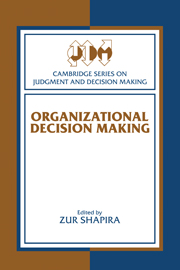Book contents
- Frontmatter
- Contents
- Series preface
- List of contributors
- Editor's preface
- Part I Introduction
- 1 Introduction and overview
- 2 Understanding how decisions happen in organizations
- Part II Information processing and attention allocation
- Part III Preference processing
- Part IV Decision processes
- Part V Alternative approaches
- Name index
- Subject index
2 - Understanding how decisions happen in organizations
Published online by Cambridge University Press: 06 August 2010
- Frontmatter
- Contents
- Series preface
- List of contributors
- Editor's preface
- Part I Introduction
- 1 Introduction and overview
- 2 Understanding how decisions happen in organizations
- Part II Information processing and attention allocation
- Part III Preference processing
- Part IV Decision processes
- Part V Alternative approaches
- Name index
- Subject index
Summary
A large part of contemporary research on organizational decision making is concerned with how decisions should be made. Such research seeks techniques for improving the intelligence of actions by organizational decision makers. This chapter is, on the other hand, only incidentally concerned with how decisions should be made. It focuses on how decisions actually happen in organizations and how we might think about decision processes. It is an introduction, a sketch of ideas that might be relevant to understanding decision making in organizations. The chapter is neither a substitute for nor an adequate prologue to the other contributions in this volume. At best, it sets a partial frame for considering the more elaborated versions of other chapters.
Introduction
In one of those extraordinary epigrams that become part of the folklore of a field, James Duesenberry (1960, p. 233) said that “economics [and by analogy psychology] is all about how people make choices; sociology [and by analogy anthropology and political science] is all about how they don't have any choices to make.” Students of organizational decisions locate themselves happily in the midst of the distinction, trying to understand decisions as instruments of conflict and consciousness and trying to understand conflict and consciousness as embedded in social relations, rules, norms, and constraints (Allison, 1971; Hickson, 1995; March, 1981, 1988, 1994a; Pennings, 1986; Witte & Zimmerman, 1986; Zey, 1992).
- Type
- Chapter
- Information
- Organizational Decision Making , pp. 9 - 32Publisher: Cambridge University PressPrint publication year: 1996
- 23
- Cited by



